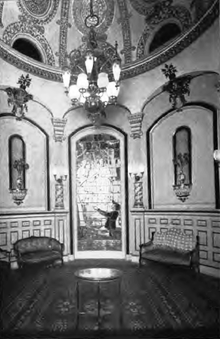
In the Latter Day Saint movement, the second anointing is the pinnacle ordinance of the temple and an extension of the endowment ceremony.[1][2]: 11 Founder Joseph Smith taught that the function of the ordinance was to ensure salvation, guarantee exaltation, and confer godhood.[5] In the ordinance, a participant is anointed as a "priest and king" or a "priestess and queen", and is sealed to the highest degree of salvation available in Mormon theology.[6]: 286
In the Church of Jesus Christ of Latter-day Saints (LDS Church), Mormonism's largest denomination, the ordinance is currently only given in secret to select couples whom top leaders say God has chosen.[7] The LDS Church regularly performed the ceremony for nominated couples from the 1840s to the 1920s, and continued less regularly into the 1940s.[2]: 40 By 1941, about 15,000 second anointings had been performed for the living, and over 6,000 for the dead.[2]: 41 The practice became much less common thereafter,[2]: 42 but has continued into modern times.[9] Most modern LDS adherents are unaware of the ritual's existence.[10] Instructors in the church's institutes of religion are told, "Do not attempt in any way to discuss or answer questions about the second anointing." (emphasis in the original).[11] The ordinance is also performed by many Mormon fundamentalist groups. However, it is not performed by denominations such as the Community of Christ, who historically did not practice the Nauvoo endowment ceremony.[12][13][14]
- ^ Blythe, Christopher James (May 2011). Recreating Religion: The Response to Joseph Smith Innovations in the Second Prophetic Generation of Mormonism (MA). Utah State University. p. 31.
Smith revealed the pinnacle ordinance of Mormonism, the second anointing .... Through this ceremony, Joseph Smith ordained [Alpheus] Cutler to the office of king and priest, a position that contained the fullness of the Melchizedek Priesthood.
- ^ a b c d e f Buerger, David John (1983). "'The Fulness of the Priesthood': The Second Anointing in Latter-day Saint Theology and Practice" (PDF). Dialogue. 16 (1). University of Illinois Press: 10–44. doi:10.2307/45225125. JSTOR 45225125.
- ^ Cite error: The named reference
Highwas invoked but never defined (see the help page). - ^ a b Cite error: The named reference
Mysterieswas invoked but never defined (see the help page). - ^ [3]: 189, 191 [2]: 21, 36–37 [4]: 89
- ^ Hammond, Elizabeth (November 2, 2015). "The Mormon Priestess: A Theology of Womanhood in the LDS Temple". In Brooks, Joanna; Hunt Steenblik, Rachel; Wheelwright, Hannah (eds.). Mormon Feminism: Essential Writings (1st ed.). Oxford University Press. ISBN 978-0190248031.
- ^ Cite error: The named reference
Silencewas invoked but never defined (see the help page). - ^ Quinn, D. Michael (1992). "Mormon Women Have Had the Priesthood Since 1843". In Hanks, Maxine (ed.). Women and Authority: Re-emerging Mormon Feminism. Salt Lake City: Signature Books. p. 377. ISBN 1-56085-014-0. Archived from the original on February 9, 2022 – via Internet Archive.
Currently some women have received this 'fullness of the priesthood' with their husbands. In the Salt Lake temple, the second anointing still occurs in the 'Holy of Holies' room which James E. Talmage wrote 'is reserved for the higher ordinances in the Priesthood...' The second anointing for both men and women is distinct from ordination to church priesthood offices.
- ^ [8][2]: 42–43 [4]: 66
- ^ Brooke, John L. (May 31, 1996). The Refiner's Fire: The Making of Mormon Cosmology, 1644-1844. Cambridge, UK: Cambridge University Press. p. 294. ISBN 978-0521565646.
The frequency of second anointings declined after the turn of the century, and they were virtually eliminated under the authority of Heber J. Grant in the 1920s, to the point that modern Mormons are generally unaware of the rituals existence ....
- ^ "Chapter 19: Eternal Life". Doctrines of the Gospel Teacher Manual (Religion 430 and 431). Salt Lake City, Utah: LDS Church. 2000 [1987]. Archived from the original on February 28, 2023. Retrieved April 7, 2023 – via Internet Archive.
Caution: Exercise caution while discussing the doctrine of having our calling and election made sure. Avoid speculation. Use only the sources given here and in the student manual. Do not attempt in any way to discuss or answer questions about the second anointing.
- ^ Rich, Ben E. (August 5, 2018). "The 'Reorganized' Church vs. Salvation for the Dead by Joseph F. Smith, Jr. 1905". Scrapbook of Mormon Literature, Vol. 1: Religious Tracts (Classic Reprint ed.). London, UK: Forgotten Books. p. 82. ISBN 978-1331622215.
- ^ Compilation of General Conference Resolutions, 1852-1907. Lamoni, Iowa: Community of Christ. 1908. pp. 82–83 – via Google Books.
Adopted April 9, 1886 ... No. 308 ... 3. ... That as to the alleged 'temple building and ceremonial endowments therein,' that we know of no temple building, except as edifices wherein to worship God, and no endowment except the endowment of the Holy Spirit of the kind experienced by the early saints on Pentecost Day.
- ^ Smith, Elbert A. (1949). Differences That Persist Between the RLDS and the Utah Mormon Church (PDF). Independence, Missouri: Herald Publishing House. p. 12. Retrieved April 7, 2023.
In the Kirtland Temple of the Reorganized Church [Community of Christ], there are no secret meetings of any kind, no secret rites, ceremonies, oaths, or practices. All meetings are open to the public, and no parts of the building are closed to the public; everything may be visited under guide service. ... Not one of the sacraments and ordinances ... is secret. Their nature may be freely revealed to the world. They are not guarded by secret oaths or obligations or secret covenants.
